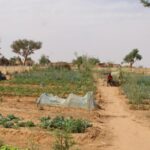Introduction
Rural agriculture is the backbone of many African economies, yet it remains one of the most underdeveloped sectors, contributing to widespread poverty in rural areas. Traditional agricultural practices often fail to address the unique challenges faced by smallholder farmers, such as limited access to resources, market constraints, and climate change. Human-centered design (HCD), a problem-solving approach that prioritizes the needs, experiences, and input of end users, offers a transformative way to address these challenges. This article explores how HCD can revolutionize rural agriculture in Africa and contribute to the fight against poverty.
Understanding the Needs of Rural Farmers
At the core of human-centered design is the deep understanding of the end users—in this case, rural farmers. HCD involves engaging with farmers directly to learn about their specific needs, challenges, and aspirations. This might include understanding the difficulties they face in accessing quality seeds, tools, or information about weather patterns and market prices.
By involving farmers in the design process, solutions can be tailored to their real-life conditions rather than imposing one-size-fits-all approaches. For example, if a community struggles with unreliable rainfall, HCD might lead to the development of affordable and easy-to-use irrigation systems that cater specifically to their environment and financial constraints.
Designing Practical and Sustainable Solutions
Human-centered design emphasizes the creation of practical, sustainable solutions that are not only effective but also accessible and affordable. In rural agriculture, this can mean designing tools, technologies, and systems that are simple to use, easy to maintain, and scalable.
For instance, a human-centered approach to designing agricultural equipment might result in tools that are lightweight and durable, tailored to the physical capabilities and working conditions of smallholder farmers. Similarly, sustainable farming practices and products, such as composting toilets or organic fertilizers, can be designed with input from farmers to ensure they are both effective and ecologically sound.
Empowering Farmers Through Education and Training
HCD is not just about designing products but also about empowering users with the knowledge and skills to use those products effectively. In rural agriculture, this could involve the development of training programs that are accessible and relevant to farmers’ daily lives.
For example, HCD can inform the creation of mobile-based educational platforms that provide farmers with real-time information on best practices, pest management, and market trends. These platforms can be designed with user-friendly interfaces that accommodate low literacy levels, ensuring that all farmers can benefit from the knowledge being shared.
Enhancing Market Access and Economic Opportunities
One of the biggest challenges facing rural farmers in Africa is accessing markets to sell their produce at fair prices. HCD can address this by designing systems and networks that connect farmers directly with buyers, reducing the number of intermediaries and ensuring better income for the producers.
This might involve creating cooperative models that allow farmers to pool resources and negotiate better prices, or digital platforms that enable direct sales to consumers in urban areas. By focusing on the needs and constraints of rural farmers, these solutions can be designed to be more inclusive and equitable.
Building Resilience Against Climate Change
Climate change poses a significant threat to agriculture in Africa, with unpredictable weather patterns and extreme conditions becoming more common. Human-centered design can play a crucial role in developing adaptive strategies that help farmers build resilience against these challenges.
For example, HCD can lead to the design of crop varieties that are more resistant to drought or floods, or to the creation of early warning systems that help farmers prepare for extreme weather events. By involving farmers in the design process, these solutions can be tailored to local conditions and ensure that they are both effective and widely adopted.
Fostering Community Collaboration and Ownership
Human-centered design encourages collaboration and co-creation, fostering a sense of ownership among the communities involved. In rural agriculture, this means that farmers are not just passive recipients of aid but active participants in the design and implementation of solutions.
This collaborative approach can lead to the development of agricultural cooperatives, community seed banks, or shared processing facilities, all designed with input from the farmers who will use them. This not only improves the effectiveness of these initiatives but also strengthens community bonds and resilience.
Conclusion
Human-centered design has the potential to revolutionize rural agriculture in Africa by creating solutions that are deeply rooted in the needs and realities of farmers. By prioritizing practicality, sustainability, and community collaboration, HCD can drive innovations that improve agricultural productivity, enhance market access, and build resilience against climate change. Ultimately, these advancements can play a critical role in combating poverty and improving the livelihoods of millions of rural Africans. Investing in human-centered design is not just about creating better products—it’s about empowering communities and transforming the future of rural agriculture in Africa.



